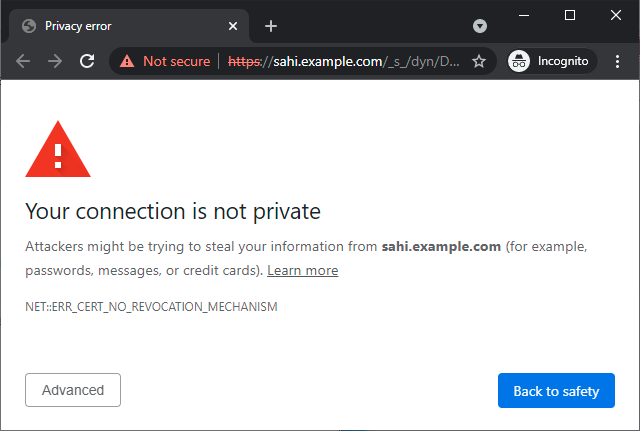SSL Issues
Handshake failure
symptom
When connecting to a HTTPS site, any browser opened from the Sahi Dashboard fails to connect, with an error message
Received fatal alert: handshake_failure. Sahi can not connect to the desired URL.
resolution
Check if you are able to connect to https://www.google.com via Sahi.
If not, then look at the instructions given here.
If you could access https://www.google.com, but not your other sites, follow what is given below. The fact that you could connect to https://www.google.com means that the Sahi SSL mechanism itself is working fine.
It is possible that these servers have certificates with a weaker algorithm. To fix it, please do the following:
If not, then look at the instructions given here.
If you could access https://www.google.com, but not your other sites, follow what is given below. The fact that you could connect to https://www.google.com means that the Sahi SSL mechanism itself is working fine.
It is possible that these servers have certificates with a weaker algorithm. To fix it, please do the following:
-
See what your java path is from the Controller->Info tab. You should see something like this:
Java Installed Directory: D:\Dev\Programs\jdk8\jre -
Open
<jre_dir>/lib/security/java.securityfile in a text editor. (In our case, it is D:\Dev\Programs\jdk8\jre\lib\security\java.security) -
Look for
jdk.certpath.disabledAlgorithms. In our case, it looks like:jdk.certpath.disabledAlgorithms=MD2 -
Comment it out, so that it looks like this:
#jdk.certpath.disabledAlgorithms=MD2 - Restart Sahi, and check again.
Certificate revocation error in Google Chrome
symptom
Connecting to any HTTPS site from Google Chrome browser fails to connect, with an error message 
NET::ERR_CERT_NO_REVOCATION_MECHANISM.

resolution
Sahi creates a dummy certificate for an HTTPS connection between the browser and Sahi. If Google Chrome performs its certificate revocation checking, this error occurs. To fix it, do the following:
-
Open the Registry Editor in Windows. Go to
HKEY_LOCAL_MACHINE\SOFTWARE\Policies\Google\Chrome. -
Set the value as 0 for
RequireOnlineRevocationChecksForLocalAnchorskey of typeREG_DWORD. Create this key if it does not exist.





